新概念英语青少版1B:Unit 22 Watching the neighbours 课件(41张PPT,音视频为嵌入)
文档属性
| 名称 | 新概念英语青少版1B:Unit 22 Watching the neighbours 课件(41张PPT,音视频为嵌入) | 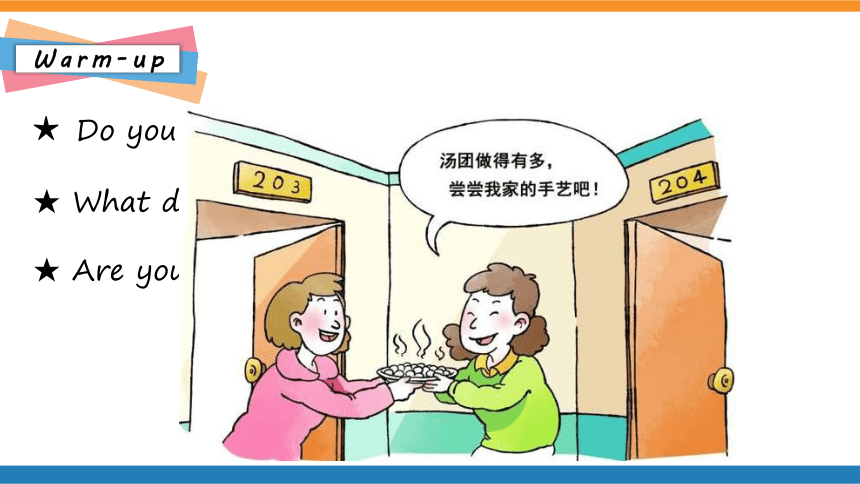 | |
| 格式 | zip | ||
| 文件大小 | 21.6MB | ||
| 资源类型 | 教案 | ||
| 版本资源 | 新概念英语 | ||
| 科目 | 英语 | ||
| 更新时间 | 2019-06-18 17:00:02 | ||
图片预览

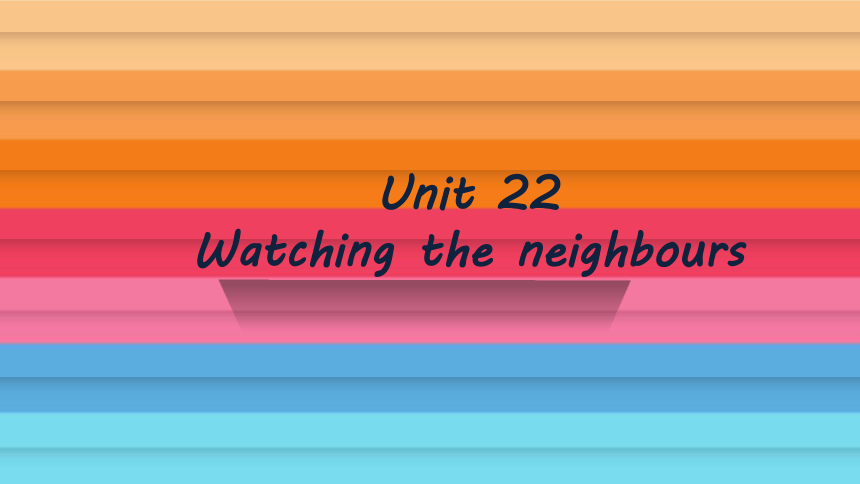
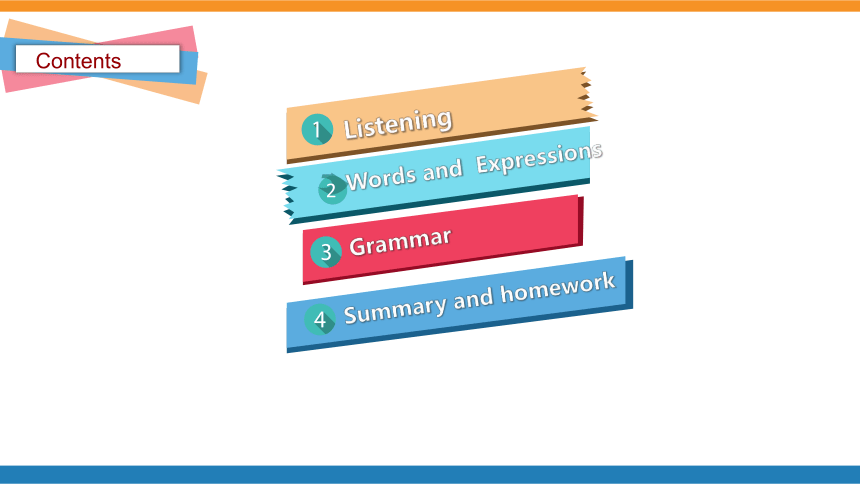
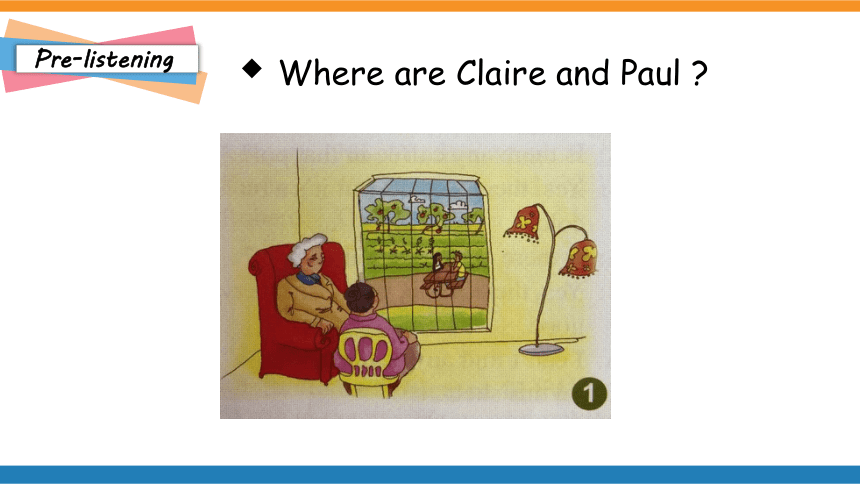

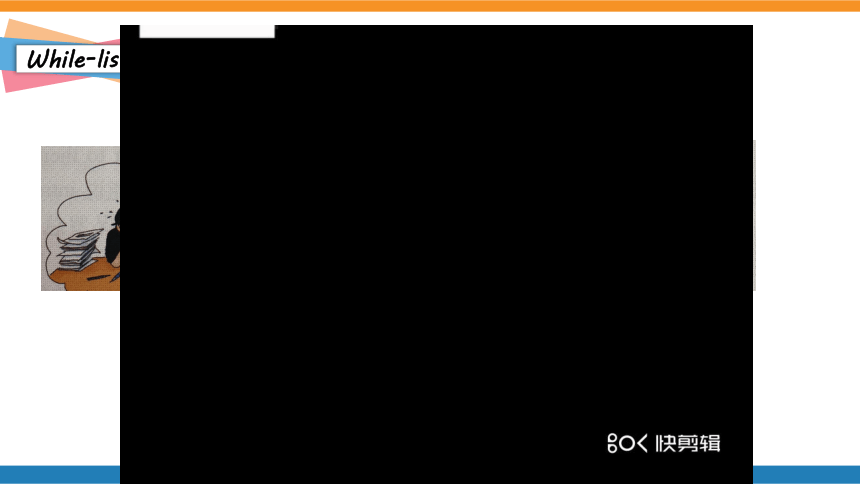
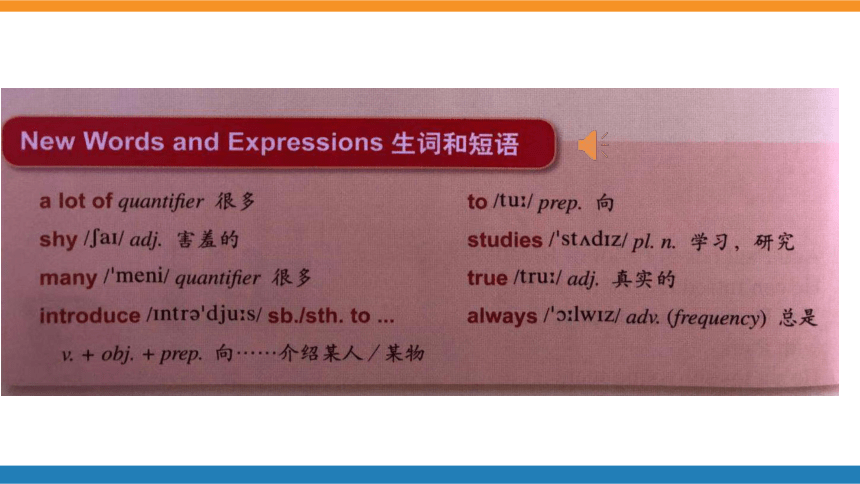
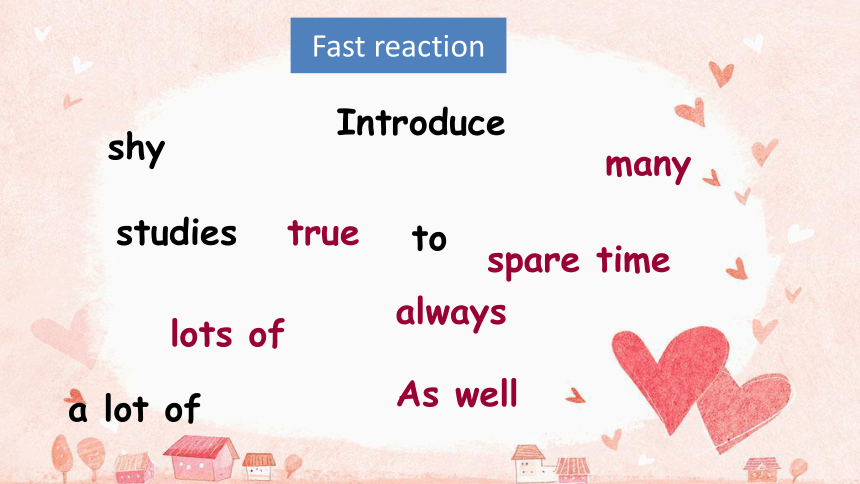
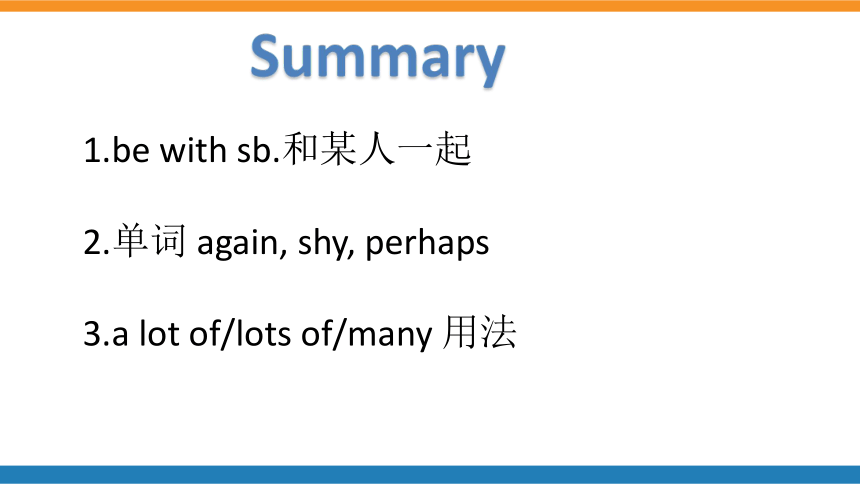
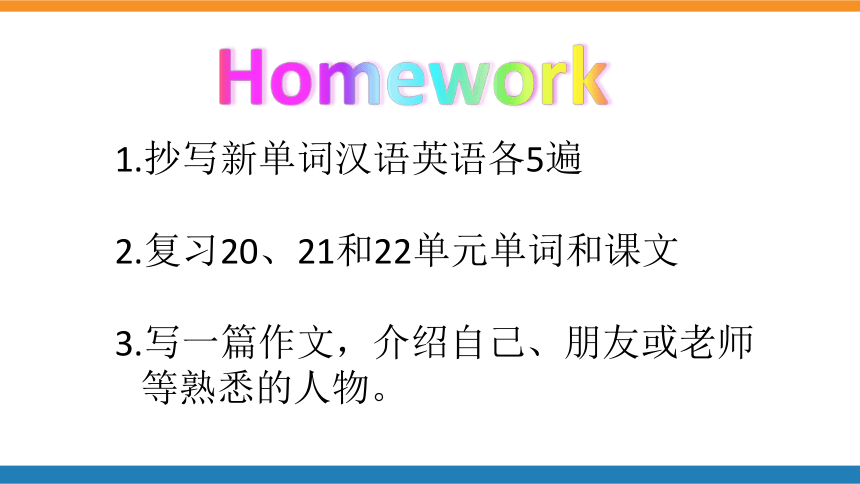
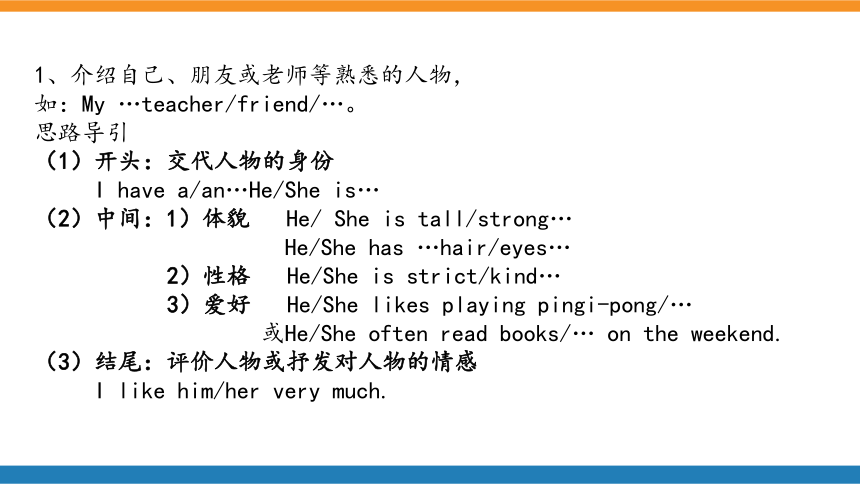

文档简介
课件41张PPT。★ Do you know your neighbours well?
★ What do they often do in spare time?
★ Are you happy with your neighbours?Unit 22
Watching the neighbours◆ Where are Claire and Paul ?◆ Where are Claire and Paul ?
◆ Who's always busy? Claire or Paul?They're in Karen's garden.They're both very busy with their studies. But Paul's always busy.newhas got lots
of friendslovelyshyhasn't got
many friendsListen again and match.toIntroduce alwaysstudiestruemanyshylots of a lot of spare timeAs wellFast reactionSummary 1.be with sb.和某人一起
2.单词 again, shy, perhaps
3.a lot of/lots of/many 用法Homework1.抄写新单词汉语英语各5遍
2.复习20、21和22单元单词和课文
3.写一篇作文,介绍自己、朋友或老师
等熟悉的人物。1、介绍自己、朋友或老师等熟悉的人物,
如:My …teacher/friend/…。
思路导引
(1)开头:交代人物的身份
I have a/an…He/She is…
(2)中间:1)体貌 He/ She is tall/strong…
He/She has …hair/eyes…
2)性格 He/She is strict/kind…
3)爱好 He/She likes playing pingi-pong/…
或He/She often read books/… on the weekend.
(3)结尾:评价人物或抒发对人物的情感
I like him/her very much. 第二次课Listening and understandingPolly: There’s Claire in Karen’s garden.
Look, she’s with Paul again.
Annie: Yes. They are very good friends .通常放在动词短语的最后。 be with sb. 和某人在一起
He is in the garden with his father. Claire is on the London Eye with her father and mother. Karen is in the room with William.Listening and understandingPolly: Has she got a lot of friends now, Annie?
Annie: Well, she’s very new here. And she’s shy. Perhaps she hasn’t got many friends. 通常表示赞许,用于形容那些在社交中不主动的人。 可与maybe互换使用;用于提出建议或进行试探性的解释。通常放在主语前面或动词短语的最后。 在与have got 和 there are 连用时,a lot of 更常使用。
在疑问和否定陈述句中我们用many+可数名词Listening and understanding:Polly: Well, there are lots of nice
girls at the art college.
lots of = a lot of很多,许多
后可接可数名词复数与不可数名词
Listening and understanding:Annie: And Paul has got a lot of friends.
He can introduce her to them.
Polly: Yes. Perhaps she’s happy with Paul.
He is a lovely young man. 表示“可能性”及物动词后跟名词或代词作直接宾语。introduce+宾语+to+名词或代词宾语。introduce
★introduce sb to... 向......介绍某人
Please introduce me to your friend.
请把我介绍给你的朋友。
★introduce sth to... 向... 介绍某物
Let me introduce the food to you.
让我来给你介绍这个食物。Listening and understandingAnnie: And they’re both very busy with their studies.
They haven’t got a lot of spare time.
Polly: That’s true. Paul’s always busy.
Now tell me about Claire’s mother…always 与现在时连用。表示“永久性真理”。总是1)be busy with忙于做…
2)studies—study
n.研究,学习,学业(study的复数)
v.学习(study的第三人称单数)
3)spare time业余时间
always 总是, 一直I always get up early.
She always eats hamburgers.
Pigs are always lazy.
* always 放在be动词后面,实义动词前面。
连词成句 She late always for is school
She is always late for school. 名词可分为可数名词和不可数名词。可数名词有单复数之分,前面可加数词或冠词。可数名词包括:
(1) 普通名词;
(2) 集体名词;
(3) 少数专有名词。
如: boy, book, family等都是可数名词。名词变复数
1.一般+s
2.以s,x,ch,sh 结尾+es
3.以辅音+y 变ies
4.以f,fe结尾 去f ,fe 变ves
“ies”“es”“ves”①②③④1.一般+s2.以s,x,ch,sh
结尾+es3.以辅音+y
变ies4.以f,fe结尾
去f ,fe 变ves不可数名词
不可数名词主要包括两大类:物质名词与抽象名词。物质名词表示无法为个体的实物,如:食物、水、金属等,例如:rice, coffe, meat, bread, water, tea.抽象名词为动作、状态、品质等无法计数的抽象概念,例如:advice, knowledge, shame, heat.不可数名词的口诀:
茶水米面雨肉奶,
tea, water,rice,bread,fish,meat,mlik?
果食钱饭雨雪纸???
fruit, food, money, 三餐,rain, snow, paper ????????????????????
光头时空作橘糖,?
light,hair,time,air,homework,orange,sugerWhat?about...的用法(······怎么样?)
“What?about...?”是一句常用的客套话,它后面可接名词、代词或动词-ing形式。????
1、What about this bike?
这辆自行车怎么样?
2、I'd?like?a?cup?of?tea.?What?about?you??
我想喝杯茶,你呢?
3、What about playing football now?
现在踢足球怎么样?
I① clean the window ②③ at home④ on sundays ⑤.
1.对主语提问:Who cleans the window at home on Saturdays?
2.对宾语提问:What do you clean at home on Saturdays?
3.对谓语和宾语提问:What do you do at home on Saturdays?
4.对地点状语提问:Where do you clean the window on Saturdays?
5.对时间状语提问: When do you clean the window at home?
总结:特殊疑问句是以特殊疑问词开头,对句中某一成分提问的句子叫特殊疑问句。
a.对划线部分提问,划线部分不能再出现。
b. 特殊疑问句的结构:特殊疑问词+be动词/助动词/情态动词+其他
c.如对主语或主语的定语提问,其语序是陈述句的语序:
Who is singing in the room? Whose bike is broken?
划线部分提问特殊疑问句There be句型的提问There be句型的特殊疑问句有三种形式① 对主语提问:
当主语是人时,用 “Who’s + 介词短语?”;
当主语是物时,用 “What’s + 介词短语?”。
其中there在口语中常常省略。注意:无论原句的主语是单数还是复数,对其提问时一般都用be的单数形式(回答时却要根据实际情况来决定)。
There is a bird in the tree. →What’s in the tree?
There are some bikes over there. →What’s over there?
There is a little girl in the room. →Who is in the room?② 对地点状语提问:
用 “Where is are + 主语?”,表示(注意其答语变化)
There is a computer in my office.
→ Where is the computer? ----It’s in my office.
There are four children in the classroom.
→Where are the four children?—They’ re in the classroom. ③ 对数量提问:一般有两种提问方式:
如果主语是可数名词,无论是单数还是复数,都用“How many +可数名词复数+ are there + 介词短语?”
There are twelve months in a year.
→How many months are there in a year?
There is only one book in my bag.
→ How many books are there in your bag?
There is a cat in the box.
→ How many cats are there in the box?如果主语是不可数名词,则用“ How much + 不可数名词 + is there + 介词短语?”
There is some money in my purse.
→How much money is there in your purse?
就划线部分提问练习1.There are twenty books on the shelf.
How many books are there on the shelf?
2. Mary is in the garden.
Who is in the garden?
3. Paul has got lots of money.
What has Paul got?
4.There are many beautiful flowers in the garden.
______ ______ in the garden?
5.There is a book on the desk.
__________ _________ books are there on the desk?
6.There are some food on the plate.
__________ _________ _________ food?
WhatisHowmanyWhereareany Homework
就划线部分提问
1.There are some grapes on the table.
2.There are ten students in the classroom.
3.There is a boy under the tree.
Homework1.复习20、21和22单元单词和课文
2.写一篇作文,介绍自己、朋友或老师
等熟悉的人物。1、介绍自己、朋友或老师等熟悉的人物,
如:My …teacher/friend/…。
思路导引
(1)开头:交代人物的身份
I have a/an…He/She is…
(2)中间:1)体貌 He/ She is tall/strong…
He/She has …hair/eyes…
2)性格 He/She is strict/kind…
3)爱好 He/She likes playing pingi-pong/…
或He/She often read books/… on the weekend.
(3)结尾:评价人物或抒发对人物的情感
I like him/her very much. 谢谢观看!THANK YOU !
★ What do they often do in spare time?
★ Are you happy with your neighbours?Unit 22
Watching the neighbours◆ Where are Claire and Paul ?◆ Where are Claire and Paul ?
◆ Who's always busy? Claire or Paul?They're in Karen's garden.They're both very busy with their studies. But Paul's always busy.newhas got lots
of friendslovelyshyhasn't got
many friendsListen again and match.toIntroduce alwaysstudiestruemanyshylots of a lot of spare timeAs wellFast reactionSummary 1.be with sb.和某人一起
2.单词 again, shy, perhaps
3.a lot of/lots of/many 用法Homework1.抄写新单词汉语英语各5遍
2.复习20、21和22单元单词和课文
3.写一篇作文,介绍自己、朋友或老师
等熟悉的人物。1、介绍自己、朋友或老师等熟悉的人物,
如:My …teacher/friend/…。
思路导引
(1)开头:交代人物的身份
I have a/an…He/She is…
(2)中间:1)体貌 He/ She is tall/strong…
He/She has …hair/eyes…
2)性格 He/She is strict/kind…
3)爱好 He/She likes playing pingi-pong/…
或He/She often read books/… on the weekend.
(3)结尾:评价人物或抒发对人物的情感
I like him/her very much. 第二次课Listening and understandingPolly: There’s Claire in Karen’s garden.
Look, she’s with Paul again.
Annie: Yes. They are very good friends .通常放在动词短语的最后。 be with sb. 和某人在一起
He is in the garden with his father. Claire is on the London Eye with her father and mother. Karen is in the room with William.Listening and understandingPolly: Has she got a lot of friends now, Annie?
Annie: Well, she’s very new here. And she’s shy. Perhaps she hasn’t got many friends. 通常表示赞许,用于形容那些在社交中不主动的人。 可与maybe互换使用;用于提出建议或进行试探性的解释。通常放在主语前面或动词短语的最后。 在与have got 和 there are 连用时,a lot of 更常使用。
在疑问和否定陈述句中我们用many+可数名词Listening and understanding:Polly: Well, there are lots of nice
girls at the art college.
lots of = a lot of很多,许多
后可接可数名词复数与不可数名词
Listening and understanding:Annie: And Paul has got a lot of friends.
He can introduce her to them.
Polly: Yes. Perhaps she’s happy with Paul.
He is a lovely young man. 表示“可能性”及物动词后跟名词或代词作直接宾语。introduce+宾语+to+名词或代词宾语。introduce
★introduce sb to... 向......介绍某人
Please introduce me to your friend.
请把我介绍给你的朋友。
★introduce sth to... 向... 介绍某物
Let me introduce the food to you.
让我来给你介绍这个食物。Listening and understandingAnnie: And they’re both very busy with their studies.
They haven’t got a lot of spare time.
Polly: That’s true. Paul’s always busy.
Now tell me about Claire’s mother…always 与现在时连用。表示“永久性真理”。总是1)be busy with忙于做…
2)studies—study
n.研究,学习,学业(study的复数)
v.学习(study的第三人称单数)
3)spare time业余时间
always 总是, 一直I always get up early.
She always eats hamburgers.
Pigs are always lazy.
* always 放在be动词后面,实义动词前面。
连词成句 She late always for is school
She is always late for school. 名词可分为可数名词和不可数名词。可数名词有单复数之分,前面可加数词或冠词。可数名词包括:
(1) 普通名词;
(2) 集体名词;
(3) 少数专有名词。
如: boy, book, family等都是可数名词。名词变复数
1.一般+s
2.以s,x,ch,sh 结尾+es
3.以辅音+y 变ies
4.以f,fe结尾 去f ,fe 变ves
“ies”“es”“ves”①②③④1.一般+s2.以s,x,ch,sh
结尾+es3.以辅音+y
变ies4.以f,fe结尾
去f ,fe 变ves不可数名词
不可数名词主要包括两大类:物质名词与抽象名词。物质名词表示无法为个体的实物,如:食物、水、金属等,例如:rice, coffe, meat, bread, water, tea.抽象名词为动作、状态、品质等无法计数的抽象概念,例如:advice, knowledge, shame, heat.不可数名词的口诀:
茶水米面雨肉奶,
tea, water,rice,bread,fish,meat,mlik?
果食钱饭雨雪纸???
fruit, food, money, 三餐,rain, snow, paper ????????????????????
光头时空作橘糖,?
light,hair,time,air,homework,orange,sugerWhat?about...的用法(······怎么样?)
“What?about...?”是一句常用的客套话,它后面可接名词、代词或动词-ing形式。????
1、What about this bike?
这辆自行车怎么样?
2、I'd?like?a?cup?of?tea.?What?about?you??
我想喝杯茶,你呢?
3、What about playing football now?
现在踢足球怎么样?
I① clean the window ②③ at home④ on sundays ⑤.
1.对主语提问:Who cleans the window at home on Saturdays?
2.对宾语提问:What do you clean at home on Saturdays?
3.对谓语和宾语提问:What do you do at home on Saturdays?
4.对地点状语提问:Where do you clean the window on Saturdays?
5.对时间状语提问: When do you clean the window at home?
总结:特殊疑问句是以特殊疑问词开头,对句中某一成分提问的句子叫特殊疑问句。
a.对划线部分提问,划线部分不能再出现。
b. 特殊疑问句的结构:特殊疑问词+be动词/助动词/情态动词+其他
c.如对主语或主语的定语提问,其语序是陈述句的语序:
Who is singing in the room? Whose bike is broken?
划线部分提问特殊疑问句There be句型的提问There be句型的特殊疑问句有三种形式① 对主语提问:
当主语是人时,用 “Who’s + 介词短语?”;
当主语是物时,用 “What’s + 介词短语?”。
其中there在口语中常常省略。注意:无论原句的主语是单数还是复数,对其提问时一般都用be的单数形式(回答时却要根据实际情况来决定)。
There is a bird in the tree. →What’s in the tree?
There are some bikes over there. →What’s over there?
There is a little girl in the room. →Who is in the room?② 对地点状语提问:
用 “Where is are + 主语?”,表示(注意其答语变化)
There is a computer in my office.
→ Where is the computer? ----It’s in my office.
There are four children in the classroom.
→Where are the four children?—They’ re in the classroom. ③ 对数量提问:一般有两种提问方式:
如果主语是可数名词,无论是单数还是复数,都用“How many +可数名词复数+ are there + 介词短语?”
There are twelve months in a year.
→How many months are there in a year?
There is only one book in my bag.
→ How many books are there in your bag?
There is a cat in the box.
→ How many cats are there in the box?如果主语是不可数名词,则用“ How much + 不可数名词 + is there + 介词短语?”
There is some money in my purse.
→How much money is there in your purse?
就划线部分提问练习1.There are twenty books on the shelf.
How many books are there on the shelf?
2. Mary is in the garden.
Who is in the garden?
3. Paul has got lots of money.
What has Paul got?
4.There are many beautiful flowers in the garden.
______ ______ in the garden?
5.There is a book on the desk.
__________ _________ books are there on the desk?
6.There are some food on the plate.
__________ _________ _________ food?
WhatisHowmanyWhereareany Homework
就划线部分提问
1.There are some grapes on the table.
2.There are ten students in the classroom.
3.There is a boy under the tree.
Homework1.复习20、21和22单元单词和课文
2.写一篇作文,介绍自己、朋友或老师
等熟悉的人物。1、介绍自己、朋友或老师等熟悉的人物,
如:My …teacher/friend/…。
思路导引
(1)开头:交代人物的身份
I have a/an…He/She is…
(2)中间:1)体貌 He/ She is tall/strong…
He/She has …hair/eyes…
2)性格 He/She is strict/kind…
3)爱好 He/She likes playing pingi-pong/…
或He/She often read books/… on the weekend.
(3)结尾:评价人物或抒发对人物的情感
I like him/her very much. 谢谢观看!THANK YOU !
同课章节目录
- Unit 16 On the London Eye
- Unit 17 Smile,please!
- Unit 18 Men can cook,too!
- Unit 19 You must eat!
- Unit 20 What a surprise!
- Unit 21 Breakfast blues
- Unit 22 Watching the neighbours
- Unit 23 An expensive camera
- Unit 24 A light dinne
- Unit 25 The weekend shopping
- Unit 26 A self-service restaurant
- Unit 27 Toothache
- Unit 28 Every day is different!
- Unit 29 Many happy returns of the day!
- Unit 30 An internation event
